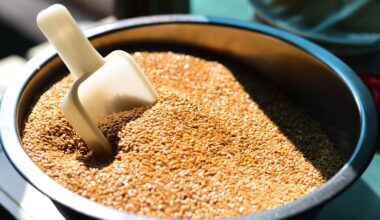The Truth About Toothpaste Flavors and Dogs’ Willingness to Brush
Many dog owners believe that specialized toothpaste flavors can influence their pets’ willingness to accept dental care. In reality, dogs are driven more by their sense of smell than taste. While a vanilla peanut butter or chicken flavor might attract a dog to the brushing process, the actual ingredients in dog toothpaste play a more crucial role. The effectiveness of a toothpaste lies within its cleaning action and its ability to promote oral health, rather than simply its appealing flavor. Gradually introducing dental care during playtime and pairing it with treats can encourage dogs to adjust to the sensation of having their teeth brushed. Flavors can entice dogs initially, but consistent practice and a positive association are necessary for long-term acceptance. It’s also essential to choose toothpaste specifically formulated for dogs. Human toothpaste often contains ingredients like xylitol, which can be toxic to canines. Selecting safe, palatable toothpaste designed for pets helps maintain oral hygiene and promotes a happier, healthier pet.
Understanding the Ingredients
When shopping for dog toothpaste, consider the composition and ingredients that affect their dental health. Many commercial toothpastes contain sodium bicarbonate, which helps to neutralize bad odors, while enzymes can help break down plaque. Additionally, fluoride, commonly found in human toothpaste, is harmful to dogs, making it essential to avoid products containing this compound. Natural formulas might also use aloe vera, which has soothing properties. Always read labels to ensure safety and effectiveness. It’s crucial to find a toothpaste that satisfies your dog’s needs while contributing positively to their oral care routine. Ingredients that encourage abrasion can help to remove plaque effectively. Surprisingly, natural flavors like malt and liver typically resonate well with dogs, facilitating their comfort. Additionally, formulations should promote anti-bacterial properties while being gentle on delicate gums. Regular brushing using the right product can reduce the need for veterinary dental procedures, saving time and money. Creating a routine can reinforce a dog’s understanding of tooth care, thus enhancing their overall dental health and encouraging them to accept the experience. Remember, always consult a veterinarian before trying new dental products on your pet.
Establishing a dental care routine that includes brushing your dog’s teeth regularly is essential for maintaining good oral health. While flavor can play a role in enticing your dog to accept brushing, the dominant factor tends to be the overall experience. The first few attempts may be met with resistance or confusion, but patience and positive reinforcement can lead to success. Use movements that mimic play or bond-building behavior, such as gentle touches and treats, to reassure your dog that brushing is a safe and rewarding activity. Consistent practice results in better acceptance over time. Additionally, maintaining a calm environment free from distractions can ease anxiety for both you and your dog. Gradually introduce the toothbrush alongside flavored toothpaste to ensure your dog associates the process with enjoyment. Rewards such as praise, treats, and special playtime after each successful session will reinforce their willingness to participate. The goal is to make dental care a normalized part of your dog’s routine. With persistence, brushing can become a bonding experience, ultimately leading to improved oral health in your furry friend.
Myths Surrounding Toothpaste Flavors
There are several myths regarding the necessity and impact of toothpaste flavors that every dog owner should be aware of. One common misconception is that dogs would prefer human toothpaste due to their flavors, which leads to dangerous outcomes like toxicity. The reality is that dogs have a different biochemical makeup than humans. Human toothpaste is often harmful, containing sweeteners and chemicals unsuitable for dogs. Some might mistakenly believe that flavor is the primary driver for dog dental health. However, a dog’s motivation to comply primarily arises from familiarity and comfort with the brushing process itself. Furthermore, some products touted as ‘flavored’ may not contain palatable ingredients for dogs, which means they might seem appealing and are, in fact, ineffective in engaging a dog. The actual cleaning action necessary for plaque removal is critical and cannot be substituted solely by appealing flavors. Proper brush technique and frequency are more significant factors influencing outcome. Educate yourself on effective dental care practices to ensure you provide the best oral hygiene for your dog without falling victim to common myths surrounding flavors.
When it comes to selecting dental care routines for dogs, many owners focus on the appearance or flavor preference of toothpaste. While the allure of a flavored product can help with initial acceptance, it’s essential to recognize its limitations. The critical components that contribute to effective dental hygiene include proper brushing technique, frequency of cleanings, and the quality of the components in the toothpaste itself. Furthermore, even if a particular flavor captures your dog’s attention, pet owners must remain vigilant regarding oral complications, as plaque build-up can progress if neglected and lead to severe dental diseases. Regular visits to your veterinarian are paramount in monitoring your dog’s oral health. Many dental disease symptoms can go unnoticed until significant damage has occurred. Treating dental issues sooner rather than later not only enhances your dog’s quality of life but potentially avoids costly long-term treatments. Ultimately, a comprehensive dental hygiene strategy assures a healthier mouth, thus significantly improving the overall health of your beloved pet over time. Be proactive, choose wisely, and ensure your dog receives essential dental care routine without unnecessary focus on flavors.
The Importance of Early Training
Training your dog to accept dental care from an early age creates a foundation for lifelong health. Puppies, like human infants, adapt to new experiences more readily than adult dogs. Starting dental care early, preferably during their initial months, can create a positive association. Puppies are typically more curious and open to exploration. Introducing brushing with flavored toothpaste can enhance this experience. As they mature, this familiarity with dental care encourages cooperation and reduces anxiety during the process. Gradually extending the duration and frequency of brushing sessions can make it a routine that eventually becomes habitual. Furthermore, consistently rewarding positive behavior reinforces this association, demonstrating the importance of rewards like playtime and treats after brushing. Engaging in a positive, relaxed approach leads to a successful outcome. If dental hygiene is neglected in early stages, older dogs may resist due to unfamiliarity or discomfort. Addressing dental health as a continuous training process ensures your dog maintains great oral hygiene without unwanted struggles. Educate yourself thoroughly to ensure early training establishes a healthy habit for your dog that can last a lifetime.
One must remember that dog dental care extends beyond brushing alone. While selecting the right flavored toothpaste can initially entice your dog, adopting a multi-faceted approach toward dental hygiene ensures long-term benefits. Regular vet check-ups, dental chews, and appropriate diet play significant roles in your pet’s overall oral health. Chew-friendly items can help remove bits of plaque naturally, complementing toothbrush efforts. Incorporating dental treats designed to promote oral health can be both enjoyable and beneficial for dogs. Additionally, keeping your dog fit and healthy in general can impact their dental hygiene positively. Ensuring they consume a balanced diet rich in nutrients can fortify their defenses against oral problems. Hydration also plays a benefactor role that enhances salivary function, which can naturally help cleanse the mouth. Exploring a holistic approach combining various practices aids in improving your pet’s well-being. Always consult with your veterinarian for recommendations tailored to your dog’s unique needs. Practicing diverse maintenance methods encourages strong, healthy teeth and gums. Ultimately, ensuring your canine companion enjoys a vibrant, happy life relies on proper care and guidance from dedicated owners.



